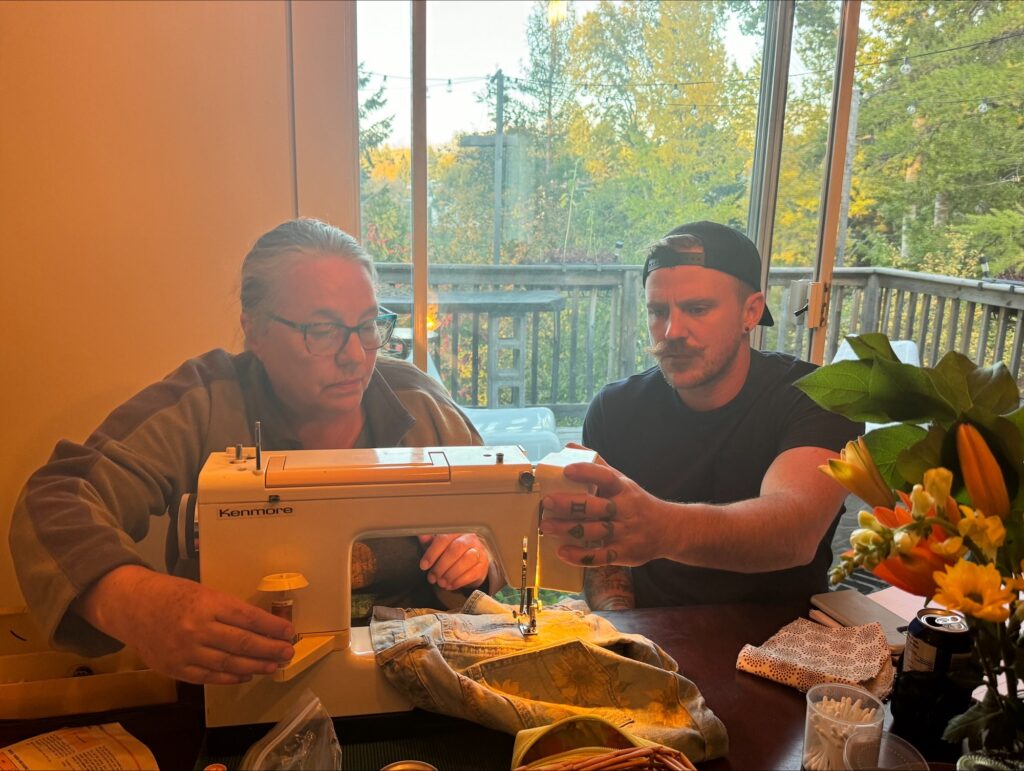I have chosen to learn how to sew for my free inquiry project. I want to go from having zero experience (in what I’m learning is a very expansive discipline) to sewing my own garment in three months. So, when I sat down to take stock of my position, I had to ask myself some questions to figure out where to start. What do I know about sewing? Nothing. How challenging is becoming a skilled tailor? Very. The task seemed daunting. Perhaps I bit off more than I could chew for this project. It was then my line of thinking changed. I need to stop thinking about what I can’t do and think about what I can. What are my skills, and how can I apply them to the task? So, I made a list
- I have 15 years of truck driving experience and have worked with or around heavy equipment my whole life.
- I have the abillity to connect with people and build strong relationships, I have been fortunate enough to create a strong network of people who have a lot of different skills.
- I learn the fastest by doing something hands-on. Once I have performed a task with my hands, I will likely never forget how to do it.
Now for the hard part: How can I apply trucking, relationships, and hands-on work to a new project? The first step was clear: I needed to reach out to friends and family and find a mentor. I needed to find Mr. Miyagi for my Karate Kid and the Yoda for my Luke. After a few calls to family members, this connection was made. My sister’s mother-in-law, Anne, loves to sew, is in town, has a machine, and is willing to teach me. I showed up at the house excited to get my project underway. “The first step,” says Anne, “is reading the manual and oiling and cleaning the machine because if you don’t start right, it’s not worth starting at all.” With this sage advice in mind, I begin reading the manual. The machine Anne was showing me how to use was a 1973 Kenmore. The machine has almost all metal parts and is in immaculate condition with all its original pieces. The manual is extensive and thick, with photos on the cover of models in chic (for the time) dresses and suits, all smiling at me. As I started to disassemble the machine and oil it, Anne explained the terminology around sewing machines to me. “This is a bobbin,” Anne says, “and it’s important that when we wind it, it stays tight so it doesn’t nest.” Immediately, I start making connections. A bobbin is like a winch cable. This machine is just a rotary-style piston. My mind is an explosion of neurons firing and working together… I know what I’m doing. In moments, with the help of the manual and guidance from Anne, I have the machine oiled, reassembled, and ready for service. We then took 20 minutes to go through terminology, and she demonstrated how to set up the machine by setting the thread. I repeat the action a few times so that it becomes engrained in my brain. After the machine was ready, we practiced. Straight seam, box seam, zig-zag, seem, depth, tension, pressure, troubleshooting. Anne was talking the whole time, her knowledge flowing. We have known each other for years, and I had no idea this woman was an expert in her field.
After 3 hours with Anne I learned the following skills and mended a pair of shorts given to me by a classmate with a patch
- How to set the pressure on the machine for different fabrics
- How to adjust and troubleshoot the tensioner
- Stitch width
- Stich length
- How to thread the machine
- How to find information on needle size for different garmets and stitches
- How to use a seam ripper to remove a pocket
- How to clean and maintain the machine.
- Most importantly to keep the manual close by at all times
Anne’s help was instrumental to my success; she was a patient teacher, had a wealth of knowledge, and was willing to give me that knowledge for free. However, taking stock of the skills I already possessed and applying them created a space where I felt safe enough to take a risk and confident enough to succeed. In a self-taught environment, learning from YouTube, I would have gotten frustrated quickly, and without the hands-on experience, the knowledge would have been promptly forgotten. Anne also shared some of the mistakes she has made in her sewing journey, allowing me to avoid those problems in the future.
People try new things and take chances on projects every day. It can be easy to approach a project and analyze everything you don’t know. This process is demoralizing and can lead to feeling overwhelmed, stressed, or scared to try. So, next time you plan a project, I want you to reflect and ask the question. What am I good at? The answers may surprise you, but they also allow you to make connections that make you feel confident enough to get in and get your hands dirty. For me, it allowed 15 years of trucking experience to assist in beginning my journey as an amateur Tailor, two professions that could not be further apart. Having Anne as a mentor also made me reflect on the process of learning a skill from another person. While helpful, the development of do-it-yourself videos and online tutorials takes something away from the learning process. Human connection and learning from someone in your community can create a positive experience and strengthen relationships. Thanks, Anne.

A photo of Anne and I working with the Kenmore Machine as we repair a classmate’s favorite shorts. Photo credit to my sister, Cassidy Shankowski.